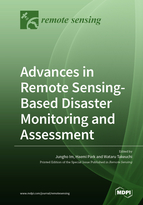Advances in Remote Sensing-based Disaster Monitoring and Assessment
A special issue of Remote Sensing (ISSN 2072-4292).
Deadline for manuscript submissions: closed (30 April 2019) | Viewed by 75571
Special Issue Editors
Interests: satellite remote sensing; aerosols; air quality; wild fire; urban heatwave; drought; artificial intelligence; machine learning; deep learning
Special Issues, Collections and Topics in MDPI journals
Interests: remote sensing of environment; disaster monitoring; climate change effects to terrestrial ecosystems; satellite-based modeling of carbon and water cycles
Interests: atmosphere and high carbon reservoirs; agriculture; urban environment assessment; natural disaster
Special Issues, Collections and Topics in MDPI journals
Special Issue Information
Dear Colleagues,
Extreme weather/climate events have been increasing partly due to on-going climate change. Such events become disasters where people live. Disaster monitoring and assessment are the most benefited areas by recent advances in satellite and airborne remote sensing. Consistent efforts in finding ways to operationally-monitor and assess disastrous events, such as floods, drought, heatwave, and forest fires, are consistently rewarded by integrating advanced remote sensing. Novel techniques in image analysis and the scheduled launch of a series of new sensors with enhanced specifications are also promising for disaster monitoring and assessment, which aims at reducing the risks caused by disasters.
Towards this end, a Special Issue of Remote Sensing on “Advances in Remote Sensing-based Disaster Monitoring and Assessment” has recently been announced. This Special Issue focuses on disaster monitoring and assessment caused by natural hazards, such as drought, floods, heatwave, wildfires, and landslides. You are encouraged to contribute to this Special Issue by submitting your latest research and development in the areas of, but not limited to:
- Multi-sensor data fusion for disaster monitoring
- Satellite-based hazard/disaster forecasting
- Novel techniques for remote sensing-based disaster assessment
- New approaches on vulnerability assessment for disasters
- Remote sensing-based systems for disaster monitoring and forecasting
Dr. Jungho Im
Dr. Haemi Park
Dr. Wataru Takeuchi
Guest Editors
Manuscript Submission Information
Manuscripts should be submitted online at www.mdpi.com by registering and logging in to this website. Once you are registered, click here to go to the submission form. Manuscripts can be submitted until the deadline. All submissions that pass pre-check are peer-reviewed. Accepted papers will be published continuously in the journal (as soon as accepted) and will be listed together on the special issue website. Research articles, review articles as well as short communications are invited. For planned papers, a title and short abstract (about 100 words) can be sent to the Editorial Office for announcement on this website.
Submitted manuscripts should not have been published previously, nor be under consideration for publication elsewhere (except conference proceedings papers). All manuscripts are thoroughly refereed through a single-blind peer-review process. A guide for authors and other relevant information for submission of manuscripts is available on the Instructions for Authors page. Remote Sensing is an international peer-reviewed open access semimonthly journal published by MDPI.
Please visit the Instructions for Authors page before submitting a manuscript. The Article Processing Charge (APC) for publication in this open access journal is 2700 CHF (Swiss Francs). Submitted papers should be well formatted and use good English. Authors may use MDPI's English editing service prior to publication or during author revisions.
Keywords
- Disaster monitoring
- Risk assessment
- Natural hazards
- Drought
- Heatwave
- Floods
- Wildfires
- Landslides







